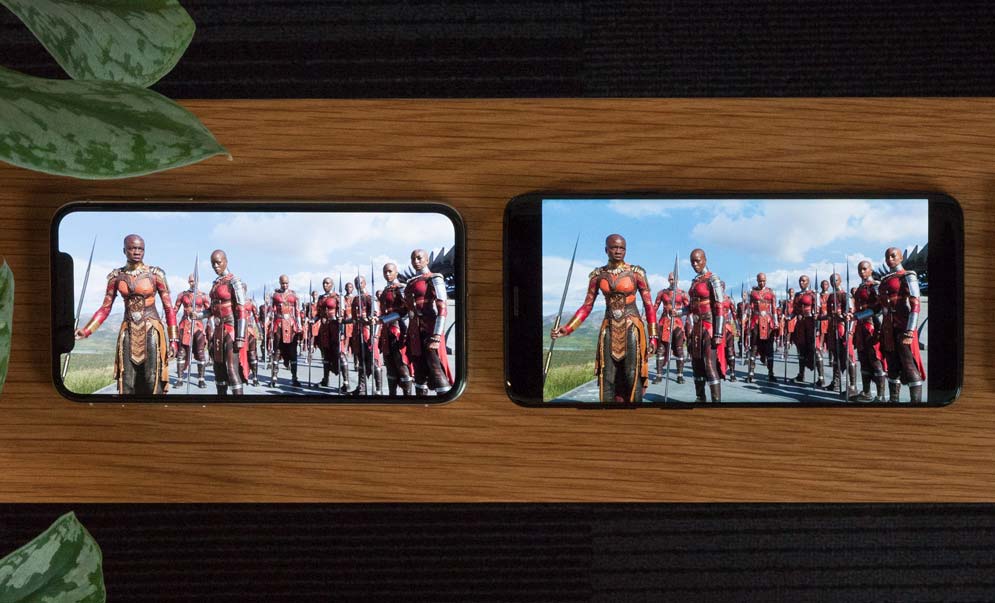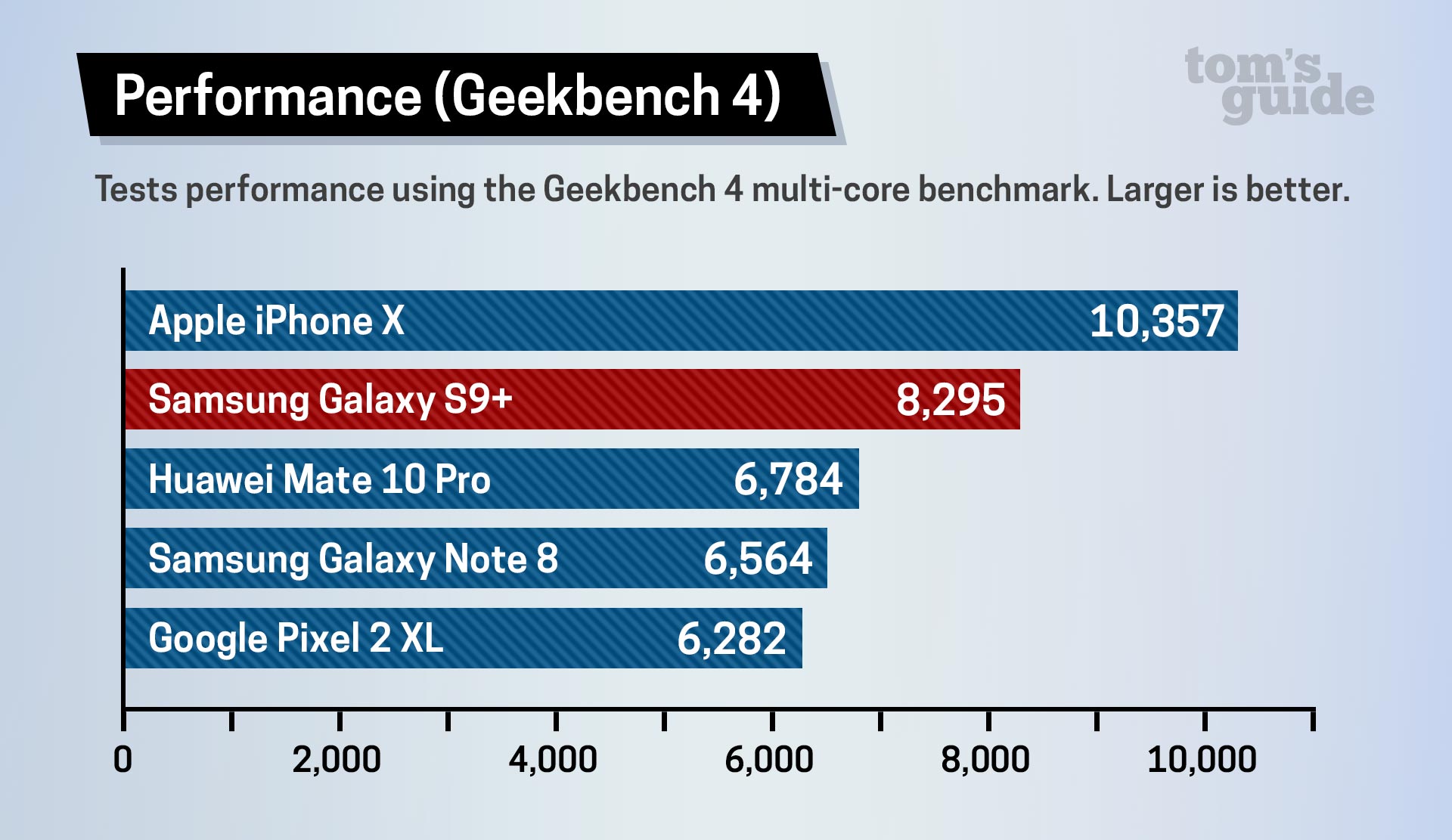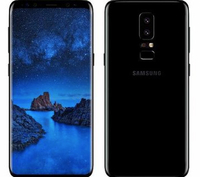The Galaxy S9 and iPhone X Battle to a Bloody TKO in 8 Rounds
Samsung's Galaxy S9 and S9+ outgun the iPhone X in several ways, but Apple's flagship has a very slight edge overall.
Samsung's Galaxy S9 and S9+ are the Android phones to beat, but do they defeat Apple's best? To find out, we compared Samsung's two new flagships with the iPhone X in eight categories, including design, cameras, display, performance and more.

Samsung's phones stand out with their curved Infinity Displays, improved low-light cameras and new augmented-reality capabilities. But the iPhone X sports an iconic design of its own, a beast of a processor and seamless Face ID security.
After adding up the scores, we found that this is one of the closest phone face-offs we've ever done. And the iPhone X emerges with a very slight edge. Updated March 16 with final Galaxy S9 battery life numbers.
Galaxy S9 and S9+ vs. iPhone X: Specs Compared
| Row 0 - Cell 0 | Galaxy S9 | Galaxy S9+ | iPhone X |
| Price | $720 - $799 | $840 - $929 | $999 |
| Display | 5.8 inches (2960 x 1440 pixels) | 6.2 inches (2960 x 144) | 5.8 inches (2436 x 1125) |
| Camera | 12-MP Super Speed Dual Pixel (f/1.5 - f/2.4) | 12-MP Super Speed Dual Pixel (f/1.5 - f/2.4); 12-MP telephoto with 2x zoom (f/2.4) | 12-MP wide angle (f/1.8); 12-MP telephoto (f/2.4) |
| Front Camera | 8 MP (f/1.7) | 8 MP (f/1.7) | 7 MP (f/1.7) |
| CPU | Snapdragon 845 | Snapdragon 845 | A11 Bionic |
| RAM | 4GB | 6GB | 3GB (Based on teardowns) |
| Storage | 64GB | 64GB | 64GB, 256GB |
| microSD | Up to 400GB | Up to 400GB | None |
| Battery | 3,000 mAh | 3,500 mAh | 2,716 mAh* |
| Battery Life (hours:minutes) | 10:49 | 10:59 | 10:40 |
| Colors | Midnight Black, Coral Blue, Lilac Purple | Midnight Black, Coral Blue, Lilac Purple | Silver, Space Gray |
| Size | 5.8 x 2.7 x 0.33 inches | 6.2 x 2.9 x 0.33 inches | 5.7 x 2.8 x 0.3 inches |
| Weight | 5.8 ounces | 6.7 ounces | 6.14 ounces |
*Based on teardowns
Design
The Galaxy S9 and S9+ are two of the sleekest smartphones on Earth, and now they have slimmer bezels to make their Infinity Displays that much more immersive. The fingerprint sensor is in a better position now, too, as it's located below the camera lens instead of to the right of it. You get three color options (Midnight Black, Coral Blue and Lilac Purple), compared with the iPhone X's two (Space Gray and Silver).

However, while the curved displays on Samsung's phones are striking, this aesthetic leads to accidental touches of the screen. I'm also not a fan of having to swipe to make the home button appear and then tap the screen again to get back to the home screen; with the iPhone X, you can do all of that with a single swipe up.

The iPhone X looks and feels more luxurious than the S9 and S9+, thanks to its stainless-steel body. But you don't get a headphone jack, as you do with the Samsung phones. As for the infamous notch on the iPhone X, I don't find it that distracting, but it does force you to swipe down from the screen just to see your battery percentage.
Winner: Galaxy S9
Display
Based on our lab tests, the Super AMOLED screens on the Galaxy S9 and S9+ are brighter than the displays on the S8 and S8+. In their adaptive modes, the S9+ and S9 are brighter than the iPhone X (630 and 603 nits, respectively, for Samsung's phones, versus 574 nits for the iPhone X).
However, indoors we found that the iPhone X’s screen was brighter at the highest setting than the Galaxy S9’s panel. You can’t force the S9’s display to get brighter, unless you go outside (or shine a flashlight on it).

On the other hand, the displays on the new Galaxy phones offer more-saturated colors, adding more pop to your videos and photos. The S9+, for example, covers 231 percent of the SRGB color gamut, compared with 128 percent for the iPhone X.
MORE: What Color Galaxy S9 Should You Buy?
Both the S9 and S9+ offer a sharper resolution of 2960 x 1440 pixels, compared with 2436 x 1125 for the iPhone X, but you don't notice the difference in everyday use. We do like that only the Samsung gives you multiple screen modes: Adaptive, AMOLED Cinema, AMOLED Photo and Basic. Basic is the closest to the iPhone X in terms of how colors are presented.
The iPhone X offers a True Tone setting, which adjusts the color of the display based on the amount of ambient light; this can come in handy when reading.
Winner: Draw
Camera
When the lights go down, the Galaxy S9 steps up with its new Super Speed Dual Pixel camera, which has an aperture that goes as wide as f/1.5. The iPhone X's shooter is limited to f/1.8, so it lets in less light. But the real proof is in the results.

In this portrait of my colleague Mike, the iPhone X does a better job with presenting warmer skin tones, while the Galaxy S9+ blew out the right side of his face. However, Samsung's camera revealed more detail in his jacket.
In side-by-side shots of some colleagues in this Manhattan bar, the Galaxy S9+ produced a much brighter image. It also beat the iPhone X with both cameras' flashes on; you can make out my colleague Caitlin in the background much better on the S9+.
The Galaxy S9 offered the best focus in this shot of a raspberry tart dessert, and the powdered sugar looks delicious. However, the red looks more luscious and the gold foil more lustrous on the iPhone X.
The Galaxy S9 and S9+ also get points for offering better Super Slow-Mo video, as they can record clips at up to 960 frames per second. The iPhone X can do only 240 fps.
However, the iPhone X beat the Galaxy S9+ overall in our photo shootout (which also included the Pixel 2), as it produced better-looking portraits without blowing out subjects in bright light. The iPhone X also captured warmer, more vibrant colors throughout multiple test shots.
MORE: Best Smartphone Camera - Phones with the Best Quality
Some of the Galaxy S9+ photos tended to make hues look washed-out, and other shots compromised brightness in darker areas, resulting in an unnatural lack of contrast.
Winner: iPhone X
Performance
The Snapdragon 845 processor inside the Galaxy S9 and S9+ provides quite a speed boost, but it's not enough to catch the A11 Bionic chip inside the iPhone X.
On our real-world video editing test, it took the S9+ 2 minutes and 32 seconds to transcode a 4K video, compared with just 42 seconds for the iPhone X. The Galaxy S9 took longer, at 3:29, likely because it has less RAM (4GB, versus 6GB for the S9+).

The Galaxy S9+ was also slower to open demanding apps, such as Injustice 2 and Tekken. The iPhone X was 5 to 7 seconds faster.
MORE: Galaxy S9 Is Fastest Android Ever, But iPhone X Is Faster
The iPhone X soundly beat the Galaxy S9+ on Geekbench 4, which measures overall performance. Apple's handset scored 10,357, compared with 8,295 for the Samsung phone. The regular S9 scored a lower 7,276.

But the Galaxy S9 and S9+ fared better on graphics tests, scoring an impressive 5,739 on 3DMark's Sling Shot benchmark, versus the iPhone X's mark of 3,998. The regular S9 notched 6,244 on this test. However, the iPhone X edged out the S9+ on the more demanding Sling Shot Extreme test (4,994 versus 4,634). The regular S9 scored a comparable 4,617.
The S9+ does offer faster LTE speeds, though, at least on T-Mobile's network. Its download speeds averaged a very high 71.6 Mbps, compared with 48.8 Mbps for the iPhone X.
Winner: iPhone X
Special Features
Samsung throws a lot of special features at the wall with the Galaxy S9, but only some of them stick.
AR Emoji is a lackluster effort to compete with Apple's Animoji on the iPhone X. The AR Emoji are supposed to look like you, but they offer only a passing resemblance. And while the GIFs you can share are fun, the video recordings that capture your facial gestures look glitchy compared to Animoji. That's at least partially because the iPhone X has a dedicated TrueDepth camera.

Then there's the Galaxy S9's augmented-reality features through Bixby Vision and the camera. The Place finder feature worked less consistently in our tests compared with Google Lens, and the live translation feature got only some words right on a Chinese menu when we pointed the S9’s camera at it.
MORE: Best Samsung Galaxy S9 and S9+ Deals
There are more practical and better-executed special features on the S9 and S9+, though, including App Pair for launching two apps side by side for multitasking. The Samsung phones also sport an always-on display (so you can see the time and other info at a glance), expandable microSD storage and an optional DeX Pad that turns Samsung's phones into mini PCs that you can attach to a monitor and keyboard. (Samsung hasn't yet revealed a price for the DeX Pad.)

The iPhone X doesn't have a ton of features, but those that are included work well, including Face ID, Animoji and Portrait Mode for the front camera. Also, the iPhone X benefits from regular updates to its operating system, whereas you sometimes have to wait nearly a year for the next version of Android to arrive on Samsung's phones.
Winner: Galaxy S9
Security
The Galaxy S9 and S9+ give you a new way to unlock your phone. Called Intelligent Scan, it combines iris recognition and facial recognition. If one method fails, the other will kick in. The problem is that Samsung admits that the facial recognition can be fooled by a photo, and you can't use Intelligent Scan for things like Samsung Pay. Instead, you have to use the phone's fingerprint sensor.

The iPhone X sticks with Face ID, which is more secure than Intelligent Scan and a bit faster. To unlock your device, all you need to do is swipe up on the iPhone X, and the phone uses its 3D sensor to look for your face. Plus, Face ID works with Apple Pay.
Winner: iPhone X
Battery Life and Charging
With its 3,500-mAh battery, the Galaxy S9+ lasted a very good 10 hours and 59 minutes on the Tom's Guide Battery Test. That's about an hour more than the smartphone average and a bit longer than the runtime turned in by the iPhone X (10:49). The Galaxy S9 lasted a very good 10:40 on the same test.

Where the Galaxy S9 and S9+ really excel is fast charging. The included charger can get you to 38 percent in just 30 minutes. The iPhone X can get to 50 percent in the same amount of time, but only if you buy a separate 29-watt USB-C power brick and a USB-C-to-Lightning cable.
Winner: Galaxy S9
MORE: Smartphones with the Longest Battery Life
Value
The Galaxy S9 ($720) and S9+ ($840) cost significantly less than the iPhone X ($999), though the price of Samsung's latest phones can vary a lot from one carrier to the other. For instance, T-Mobile charges the same prices as Samsung itself, but Verizon charges $799 for the S9 and $929 for the S9+. Regardless, those numbers are less than the iPhone X's price.
Winner: Galaxy S9
Overall Winner: iPhone X
With a final score of 87 to 86, the iPhone X wins this superclose contest against the S9 and S9+ by only a point, so the bottom line is that you can't go wrong with any of these phones. Samsung wins on design, special features, battery life and charging, and especially value, while Apple's flagship wins on camera quality, performance and security. The iPhone X is also easier to use, once you get the hang of the new gestures.
| Row 0 - Cell 0 | Galaxy S9/Galaxy S9+ | iPhone X |
| Design (10) | 9 | 8 |
| Display (15) | 14 | 14 |
| Cameras (20) | 17 | 19 |
| Performance (15) | 12 | 15 |
| Special Features (5) | 4 | 3 |
| Security (5) | 3 | 5 |
| Battery Life and Charging (15) | 14 | 13 |
| Value (15) | 13 | 10 |
| Overall (100) | 86 | 87 |
If I were to pick one of the two Samsung phones, I would opt for the Galaxy S9+, because you get dual cameras (great for optical zoom and portraits); a bigger, 6.2-inch display; and 2GB of additional RAM for extra speed.
But if I had to pick one phone out of all three, it'd be the iPhone X by a nose.
Credit: Tom's Guide
Sign up to get the BEST of Tom's Guide direct to your inbox.
Get instant access to breaking news, the hottest reviews, great deals and helpful tips.
Mark Spoonauer is the global editor in chief of Tom's Guide and has covered technology for over 20 years. In addition to overseeing the direction of Tom's Guide, Mark specializes in covering all things mobile, having reviewed dozens of smartphones and other gadgets. He has spoken at key industry events and appears regularly on TV to discuss the latest trends, including Cheddar, Fox Business and other outlets. Mark was previously editor in chief of Laptop Mag, and his work has appeared in Wired, Popular Science and Inc. Follow him on Twitter at @mspoonauer.
-
davehsharp I turned in my S8 since I like the 360 cam and some other cool apps, For a I phone X 256 I stoped reading this article after seeing it's another paper weight @ 64 of internalReply


